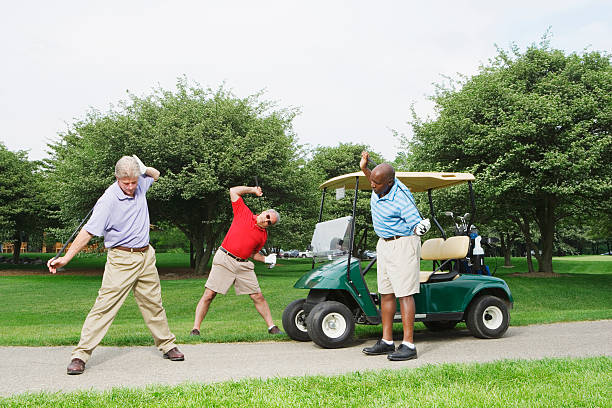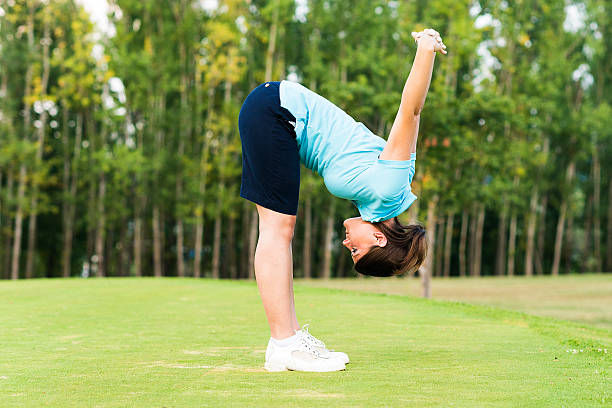9 Easy Golf Warm-Up Routine for Beginners (Avoid Injuries & Hit Better)

Table of Contents
Key Takeaways
- Warming up is important not just for physical but for mental readiness, improving your flexibility and concentration to help you play your best. A proper golf warm-up routine minimizes injury hazards by preparing your body through blood circulation and joint loosening.
- A consistent golf warm-up routine leads directly to improved swing mechanics and greater confidence while on the course. It doesn’t need to be long. Even a short, focused warm-up can work wonders.
- For optimal preparation, beginners should focus on dynamic stretching, rather than static stretching to get their bodies ready to play. Add dynamic movements that replicate the golf swing and make a difference.
- It’s all about being consistent. Make a commitment to spend specific time prior to every round warming up. Move slowly to more dynamic actions, listening to your body and how it reacts.
- Include the right exercises to build strength and stability. Add lunges with twists and bodyweight squats—they’re essential for helping you develop a repeatable swing!
- Don’t forget about cooling down post-game. Stretching after your round will help you recover and keep your flexibility, making you feel better for your next round.

Having a simple golf warm-up routine for beginners can go a long way to helping you play your best and stay injury-free on the golf course. By taking a few minutes to properly warm up your body, you can gain greater flexibility, improve blood circulation, and help your mind focus.
Key components of an effective golf warm-up routine include dynamic stretches, light aerobic exercises, and practice swings that target the muscles used in golf. For beginner golfers, basic dynamic stretches like arm circles, leg swings, and torso rotations go a long way.
When you start to integrate these movements, you build a better foundation for your game and create a much more pleasurable experience. In the next section, we’ll describe warm-up exercises and routines you can follow to warm up before hitting the course.
Importance of Warming Up
Warming up properly is an important golf warm-up routine for every golfer. Not only does it prepare the body for the dynamic sport, but it also focuses the mind for peak golf performance. This routine enhances flexibility and focus, translating to improved gameplay and a more enjoyable golf game experience.
1. Why Warming Up Matters for Golf
A balanced warm-up routine immediately translates into better swing mechanics. Participate in activities that elevate your heart rate and blood circulation! Warm up activities such as a brisk walk or walking lunges warm up joints and muscles, helping to prevent injuries.
Warming up helps golfers get mentally prepared for the game ahead and helps them create a focused mindset that is vital for achieving success.

2. Benefits of a Proper Golf Warm-Up Routine
The benefits that come with improved flexibility are too important to ignore. When it comes to executing smooth, precise swings, warmed muscles help you hit the shots you expect.
By increasing blood flow and muscle elasticity, a proper warm-up routine can help prevent strains and discomfort, making your activity more enjoyable. The confidence that comes with knowing you’re physically ready increases your ability to concentrate while you’re playing.
3. Common Misconceptions About Warming Up
Myth 3 – Warm-ups are only for serious athletes. The fact is, no matter your skill level, everyone can benefit from a proper warm-up.
Warm-ups don’t have to be time-consuming; you can get away with 7-10 minutes of dynamic stretches and movements.
5. Warming up with static stretching. Static stretching has been a popular choice for warming up before workouts. Dynamic stretches do a lot to enhance mobility and flexibility.
Comprehensive Golf Warm-Up Routine
A detailed golf warmup routine is particularly important for new golfers. In addition to preparing your body for the physical demands required in the sport, it helps prevent injuries and ensures better golf performance. Though this routine only takes about 7 to 10 minutes, it combines a series of dynamic stretches, light cardio, and practice swings.
1. Essential Warm-Up Exercises for Golf
Rotational stretches, leg swings, and arm circles are all key exercises to target muscle groups that play an important role in golf swings. These movements incorporate the entire body, targeting the upper and lower half together for improved balance and coordination.

Variations like switch-ups with dynamic leg swings or incorporating resistance bands promote muscle activation and maintain excitement and interest in a warm-up routine.
2. Key Stretches for Flexibility and Mobility
Including stretches that increase flexibility and mobility are important. Mobilize the shoulders, hips, and back with shoulder rolls, hip openers, and seated forward folds.
Progressing intensity gradually, be it intensity or durations, will prevent overloading. Gentle yoga poses are great for increasing flexibility and calming your mind, so they’ll make a perfect complement.
3. Recommended Duration for Beginners
The recommended duration for beginners is 7-10 minutes. Plan the warm-up routine in segments or blocks to prevent loss of attention.

Being consistent and sticking to this period of time will help you develop a good habit. Whether through deep breathing exercises or meditation, mental preparation techniques can improve concentration — something that will set golfers up for a successful round.
Effective Stretching Techniques
Incorporating effective stretching techniques into a golf warmup routine is not only key to improving overall golf performance but also essential for avoiding sports injuries. Understanding when to use dynamic or static stretching is crucial for many golfers, especially beginners.
1. Dynamic vs. Static Stretching Explained
Dynamic stretching is meant to help wake up and prepare muscles for intense activity by replicating the movement patterns of the sport to come. This sort of stretching gets the blood pumping and heart rate up, so it’s perfect for any pre-game warm up.
Conversely, static stretching—where you hold a stretch for around 30 seconds—works well for post-activity recovery. Dynamic stretches allow golfers to properly activate the muscles needed for a powerful and injury-free swing.
Consider adding some leg swings, arm circles, and torso twists to your pre-race routine!
2. Rotational Movements for Improved Swing
Adding in these rotational movements to your warm-up routine will help get your swing more fluid. Stretches such as trunk rotations and standing side bends warm up your core.
These muscles play an important role in a powerful, controlled swing. The more you practice these movements on and off the course, the better you will perform in all aspects of your game.
3. Upper and Lower Body Stretches
An effective stretching routine will incorporate stretches for both the upper and lower body. Here’s a bullet list of useful stretches:
- Seated hamstring stretch
- Standing quadriceps stretch
- Shoulder cross-body stretch
- Cat-cow stretch for the back
These stretches release tension and increase flexibility, further improving your range of motion.
We found that alternating between passive and active stretches greatly increases flexibility. Hold each stretch for 30 seconds to help relax the muscles!
Helpful Tips for Beginners
Warm-up routines are crucial for enhancing golf performance and reducing injury risk for beginner golfers. By incorporating a dynamic warmup routine, beginners can enjoy a more rewarding experience on the course.

1. Common Mistakes to Avoid
A lot of beginners skip or short-change their warm-up routine, thinking that doing their warm-up takes away from playing. This method can result in a lack of proper preparation and increased risk of injury.
Instead, think about including a comprehensive full body warm-up to prepare all of your major muscle groups. Ignoring certain areas, such as the hips or shoulders, can lead to imbalances and affect proper swing mechanics.
Giving time to warm up adequately helps ensure you are ready for a successful game.
2. Incorporating Breathing Techniques
Adding breathing techniques to the warm-up will help students focus and calm their nerves before class. It turns out that inhaling deeply through the nose and exhaling slowly through the mouth are not only simple practices.
These practices are effective for centering the golfer. As you stretch or take practice swings, pay attention to your breath.
That connection has incredible power to help foster feelings of calmness and focus, which can help them perform better on the course.
3. Progressing to Dynamic Movements Safely
Moving to dynamic movements gradually is important for warming the body up for the golf swing.
Progressing to dynamic movements safely means moving through low-impact motions before advancing to more vigorous actions. Focus on how your body reacts, making modifications when needed to prevent injury.
This step-by-step approach brings you to a place of both mobility and stability so that you can be prepared for the explosive demands of play.
Recommended Drills for Balance and Coordination
Incorporating balance and coordination drills into a golf warmup routine is essential for novice golfers. These exercises enhance overall muscle health and are vital for achieving a repeatable swing. Below are some of the best drills that can be performed with minimal equipment, making them accessible for the average golfer.
- Lunge with a Twist
- Bodyweight Squats
- Practice Swings

1. Lunge with a Twist for Core Engagement
This drill engages the core, which is essential for an effective swing.
How to do the lunge with a twist: Stand with feet hip width apart. Bring your right leg forward into a lunge position, keeping both knees bent at 90 degrees. As you lunge, rotate your body to the right, with arms extended.
Return to starting position and alternate legs. Keeping your form in check is very important here—make sure your knee doesn’t go past your toes.
2. Bodyweight Squats for Strength Building
Bodyweight squats are great for developing lower body strength.
Position yourself with your feet shoulder-width distance apart. Lower your body as if you’re going to sit back into a chair, keeping your chest up and your back straight.
Squats help build stability, which is key to a great swing. With stronger legs you’ll generate more power in your swing, hit longer drives and gain more control.
3. Practice Swings to Establish Rhythm
Taking practice swings builds a repeatable rhythm.
Concentrate on making fluid, well-controlled movements while drilling. Visualizing the shot while taking practice swings helps build muscle memory so they will be more fluid during actual gameplay.
Equipment to Enhance Your Warm-Up
An effective, smart golf warmup routine is an important part of any golfer’s game, especially for new golfers. The proper exercise routine can make a world of difference in improving flexibility, strength, and overall golf performance. Here’s what you’ll need for a great warm-up.
- Resistance bands
- Golf clubs
- Foam rollers
- Lightweight dumbbells
- Yoga mats
1. Using Resistance Bands Effectively
Learning how to use resistance bands will enhance your warm-up by increasing both strength and flexibility. Get started by securing the band around a stable surface and moving through movements such as shoulder pulls or leg extensions.
For your upper body, focus on bicep curls and tricep extensions. When warming up the lower body, think lateral band walks and banded squats. These muscle activation drills ensure that your muscles are ready to make the right swings in the first place.
2. Stretching with Golf Clubs
Golf clubs can be great stretching tools. With the club grip, you can use balance and resistance to stretch deeper, such as in the overhead triceps stretch or while doing a torso twist.
Both stretches help encourage flexibility, as well as range of motion. Be inventive; the club can be used to help with a variety of stretches to work multiple muscle groups for a complete warm-up.
3. Essential Gear for a Successful Routine
Essential gear goes beyond resistance bands, golf clubs, and foam rollers. Best of all, portable gear such as a compact yoga mat or lightweight dumbbells can easily be packed in your golf bag.
This helps to make them a great option for range sessions! With the proper equipment, you can establish an effective warm-up routine that prepares your body to perform its best on the pitch.

Cool Down After Playing
Giving yourself the time to cool down after a round of golf will go a long way toward ensuring effective recovery and keeping your body flexible. A good cool-down routine can work miracles on muscle soreness and stiffness.
Players experience a deeper, more meaningful game—and that’s the best play Players can make all!
1. Importance of Post-Round Stretching
Post-round stretching is a vital part of the recovery process. By increasing blood circulation in the muscles, stretching calms your muscles down to help prevent soreness and stiffness.
Keeping your body supple and limber is key to peak performance out on the course. Here’s what you need to know about doing focused stretches immediately following a round.
Use the standing quadriceps stretch, hamstring stretch and shoulder stretches to really stretch out these areas.
2. Techniques for Relaxation and Recovery
Relaxation techniques can make a big difference in your post-game routine. Foam rollers are a great adjunct for relieving muscle tension and aiding in recovery.
They are effective because they target pressure to sore areas and increase blood flow. Regularly practicing these breathing exercises can help you reduce your heart rate by a considerable amount.
Deep diaphragmatic breathing promotes relaxation and helps with recovery!
3. How to Maintain Flexibility Over Time
To keep those gains, you’ll want to incorporate flexibility work into your ongoing routine. Once you’re flexible, consistency is key to maintenance, so plan to stretch a minimum of three times weekly.
Tracking your progress can be a great source of inspiration too, encouraging you to stick with your flexibility routine.
Professional Golfers' Warm-Up Methods
Professional golfers have refined their golf warmup routine over years of competition, and these warm-up strategies play a crucial role in their overall golf performance on the course. Learning from how these professionals approach their warm-up, amateur golfers can use this knowledge to craft their own effective exercise routine before tee time.
1. Insights from Top Players
As a warm-up, these successful professional golfers usually include aspects of dynamic stretching, light cardio, and practice swings. For example, Rory McIlroy begins his warm-up routine by going for a light jog to get his heart rate up.
He follows up by going through specialized stretches to open up his hips and shoulders. Every single player finds a tailored routine that fits the needs of their body, and that’s what helps them find their best level consistently.
Beginners can learn from these strategies by observing professional play, noting techniques that resonate, and adapting them to their own comfort levels.

2. Adapting Their Routines for Beginners
For beginners, adapting the pro golfer’s routine is crucial. Begin with basic stretching and range-of-motion exercises before slowly moving to advanced routines.
Concentrating on basic movements, such as shoulder rolls or slow torso rotations, will help you establish a good base. As your confidence level increases, adding some of the things you observe in pros’ routines will help you transform your game even further.
3. Learning from Swing Analysis
Analyzing one’s swing can significantly enhance warm-up effectiveness. Newbies need to get appropriate coaching and feedback on their swing mechanics, as this can help shape their warm-up strategy.
By analyzing their swing, golfers can focus their warm-up on improving flexibility and strength in those key areas.
Key Takeaways from Your Warm-Up Routine
A consistent and effective golf warmup routine will lay the groundwork for better golf performance on the course. Knowing what to include in it can make all the difference in improving your overall game.
1. Summary of Effective Techniques
One of the most effective forms of warm-up is dynamic stretching, practice swings, and mobility drills. Dynamic stretches such as arm circles and leg swings help to wake up your muscles. They prepare you for the dynamic rotational movements of a golf swing.
Incorporating these effective techniques into your warm-up routine helps lower the risk of injury while increasing flexibility and strength. Try a variety of approaches to find out what works best for your body. This encourages a more customized experience to your warm up!
2. The Role of Consistency in Improvement
The most important aspect of improving your warm-up is consistency. Consistent regular warm-ups help create muscle memory, but they set you up for consistent long-term performance improvement.
Developing this practice of including warm-ups as part of your pre-game rituals will prepare you for success. You can set measurable goals, whether that’s increasing your swing speed or hitting more fairways, and see clear results on the course.
3. Staying Motivated and Engaged
When you change up your exercises and drills, this can help you stay engaged and motivated with your warm-up routine. Mixing in other forms of activity, such as yoga or agility drills, helps to avoid repetition.
A warm-up buddy helps keep things fun and engaging, while providing motivation and accountability to your routine.
Conclusion
Forming a regular golf warm-up routine will ensure you make the most out of your performance on the course. Not only does a proper warmup improve your golf game, but it helps prevent injury. You discovered stretches that work, drills that help, and how to use equipment to take your routine to the next level. When your body is relaxed and your mind is focused, every swing becomes more explosive.
Be consistent with your warm-up routine from game to game. That’s because it helps you establish muscle memory and hones your golf skills. Keep in mind, every golfer, beginner or professional, is different. So, whatever it may be, find what works for you.
Before you head out onto the course, make sure you get warmed-up. Have fun, and see your game get better. Looking to improve your skills on the golf course? So let’s make that warm-up a routine!
Frequently Asked Questions
What is the importance of warming up before golfing?
Warming up helps get blood flowing to your muscles, which improves your flexibility and range of motion, reducing the risk of injury. A proper golf warmup routine not only prevents injury but also prepares your body for the physical demands of the game, enhancing your overall golf performance.
How long should a warm-up routine last?
How long should a dynamic warm-up routine take? That’s plenty of time to prep your body for optimal golf performance without fatiguing you prior to your round.
What stretching techniques are best for golfers?
Prioritize a dynamic warmup routine, incorporating exercises like arm circles and leg swings. These techniques enhance golf performance by warming up muscles, encouraging a greater range of motion at impact in your golf swing.
Can beginners skip the warm-up?
Can beginners skip the golf warmup routine? Beyond increased risk of injury and sore muscles, it affects your golf performance. A proper warm-up is crucial for every player, not just beginners, to ensure a successful golf game.
What equipment can enhance my warm-up?
Instead, think about utilizing a golf club or some light resistance bands in your golf warmup routine. These training aids are perfect for warming up your body to maximize flexibility and improve your golf performance.
How should I cool down after golfing?
Cooling down after your game is crucial; dedicate 5 to 10 minutes to a dynamic warmup routine that stretches your major muscle groups. This promotes muscle recovery and minimizes soreness, preparing you for your next golf game.
What warm-up methods do professional golfers use?
Professional golfers typically utilize a combination of a golf warmup routine that includes dynamic stretching, light practice swings, and sport-specific drills. These techniques not only help with their golf posture but also prepare their bodies for optimal golf performance on the course.
This article contains affiliate links. If you purchase through them, I may earn a small commission at no extra cost to you. See our Affiliate Disclosure.






